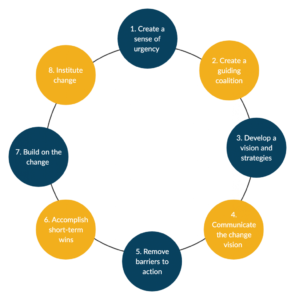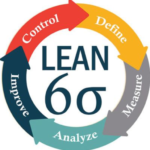Change is inevitable in any industry, and the manufacturing sector is no
exception. Implementing change in manufacturing can be a daunting task,
especially when it comes to transforming a long-standing system and process.
However, change is necessary for businesses to thrive and remain competitive
in the market.
To successfully implement change in manufacturing, businesses
can rely on a proper framework, and John Kotter’s 8 Step Change Model is one
such framework. In this article, we will explore how to use Kotter’s 8-Step
Change Model to implement change in the manufacturing industry.

Step 1: Create a Sense of Urgency
The first step in implementing change in manufacturing with Kotter’s 8-Step
Change Model is to create a sense of urgency. It is essential to establish a
sense of urgency among both managers and employees. The objective of
this step is to prepare the employees for the upcoming change and
motivate them to offer their contribution. Employees need to feel the need
for change or that change is critical for organizational growth.
To create an environment where everyone is aware of the existing
problem, businesses can identify existing threats and opportunities
affecting the organization. For instance, new technologies, changes in
market demand, and advancements of the competition are potential
threats. On the other hand, potential opportunities could be capitalizing on
the latest trends or expanding into new markets.
Businesses can openly discuss with employees about why change is
necessary at this time and create a forum to talk about the issues, threats,
and possible solutions. Seeking support from stakeholders and industry
experts to back your stance can also be helpful.
Step 2: Form a Powerful Coalition
The second step in Kotter’s 8-Step Change Model is to form a powerful
coalition. To lead the charge on a big company change, you will need allies
and stakeholders. Having other visible company members united behind
your vision sends a powerful message and helps spread support.
Businesses can identify the key change leaders and stakeholders in the
organization and ask for their support in implementing the vision. They can
create a coalition that consistently and publicly operates as a team.
Assessing the weak areas of the coalition and compensating by involving
members from across various departments and company levels is also
essential. Having diversity across job titles and levels will distribute the
strength of the vision across the myriad positions within your company.
Step 3: Create a Vision for Change
The third step in Kotter’s 8-Step Change Model is to create a vision for
change. The change process began because you had a vision for how
things could and should be done differently. You have to make that vision
clear and understandable to achieve the change you desire.
Businesses can identify the core values they want to embody in their
change and develop a mission statement that captures the most important
parts of the future they envision. Creating a logical strategy for executing
that vision, ensuring that stakeholders and members of the coalition can
communicate that vision clearly and concisely, and rehearsing the mission
and vision statement by reciting them often is necessary.
To create a clear and appealing vision, businesses can align it with values
central to the organization and the change initiative, accept the ideas of
employees when developing the vision, make sure that it can be
communicated easily and is easy to understand by everyone, incorporate
data such as forecasts, market research data, business trends, etc., and
ensure that it is simple enough to be explained in five minutes or less.
Step 4: Communicate the Vision
The fourth step in Kotter’s 8-Step Change Model is to communicate the
vision. Your organization probably has lots of communication that you will
be in competition with. For this reason, it’s not enough to just email your
vision or share it with your organization members. To effectively institute
the change, you must repeat it every chance you get and demonstrate the
behavior that you wish to see.
Businesses can speak convincingly and persuasively about their vision
often. Tying the vision to everything within the company, from operations to
company morale, and tying everything back to the vision is also essential.
Sharing the visuals created in the previous step to clearly demonstrate the
differences between current state and future state and confronting people’s
concerns and anxieties publicly and candidly is necessary.
Step 5: Remove Obstacles
The fifth step in Kotter’s 8-Step Change Model is to remove obstacles.
Expect resistance to change. To gain momentum for your vision, remove
obstacles to adopting your new idea.
Businesses can find industry leaders to reinforce the value of their change
by delivering on it. They can assess the layout of the organization and
ensure that their vision is aligned with the various levels of the organization
and vice versa. Identifying those most resistant to the change and working
to remove their concerns or creating proactive solutions around their
resistance and rewarding and recognizing those who support and
implement change in its early phase can also be helpful.
Step 6: Create Short-Term Wins
The sixth step in Kotter’s 8-Step Change Model is to create short-term
wins. Change is implemented not just by a spark, but by a consistent
current. You have to build momentum for your vision to make sure it sticks.
Short-term victories are great motivators for those who are working on your
new vision and are a great way to combat any naysayers or critics of your
vision.
Businesses can find short-term projects that aren’t costly and don’t require
sign-off from any potential opposition. Carefully selecting the right project
or target and rewarding the team members who are essential in meeting
targets is necessary.
Step 7: Build on the Change
The seventh step in Kotter’s 8-Step Change Model is to build on the
change. Early victories, while great for inciting the change, are not enough
to sustain it. Quick wins may deceive you or your teammates that the
process of change is complete, but true change must be settled with
repetition and expansion.
Businesses can analyze what went right and what went wrong after each
victory. Setting gradually more ambitious goals that can build exponential
momentum upon achievement and bringing on additional influential
stakeholders or change agents is necessary.
Step 8: Anchor the Changes in Corporate Culture
The final step in Kotter’s 8-Step Change Model is to anchor the changes in
corporate culture. Time and changes in leadership or staff can evaporate
the impact of your change. To ensure that your change remains part of the
company culture:
Businesses can talk about progress at every opportunity possible. Sharing
stories about success from your change vision and repeating stories from
others, recognizing key coalition and change members, creating
opportunities to honor their contribution and their legacy to the change you
envisioned, instilling the core values of your change into every new hire
and in your orientation process, and gaining buy-in early on from all new
leadership to sustain the legacy of the leaders before them in your
succession plan is necessary.
Conclusion
Implementing change in the manufacturing industry can be challenging, but
with Kotter’s 8-Step Change Model, businesses can systematically and
effectively implement change. Creating a sense of urgency, forming a
powerful coalition, creating a vision for change, communicating the vision,
removing obstacles, creating short-term wins, building on the change, and
anchoring the changes in corporate culture are the eight steps necessary
for successfully implementing change in the manufacturing industry.
Remember, change is necessary for businesses to thrive and remain
competitive in the market, and Kotter’s 8-Step Change Model can help
businesses achieve this







